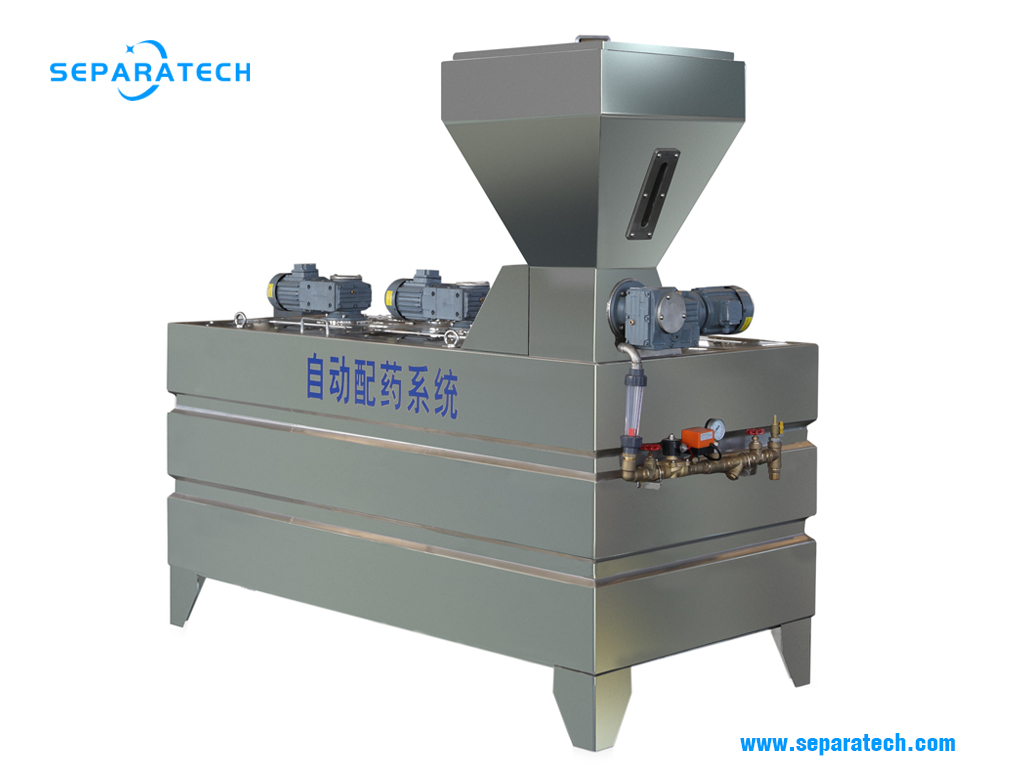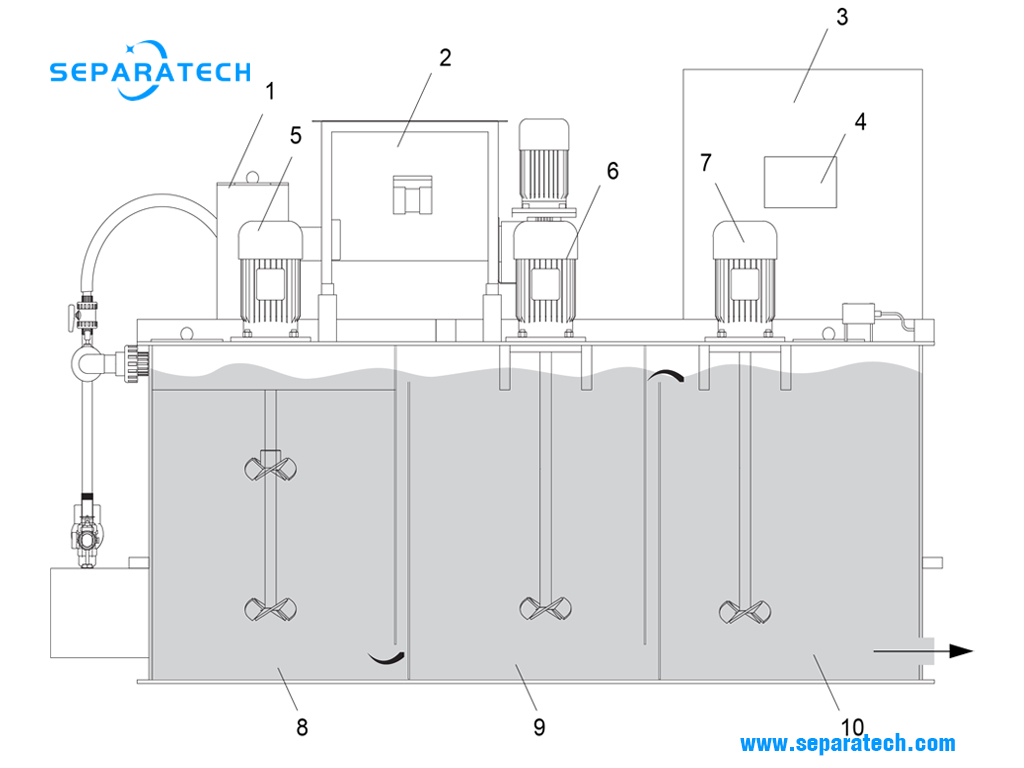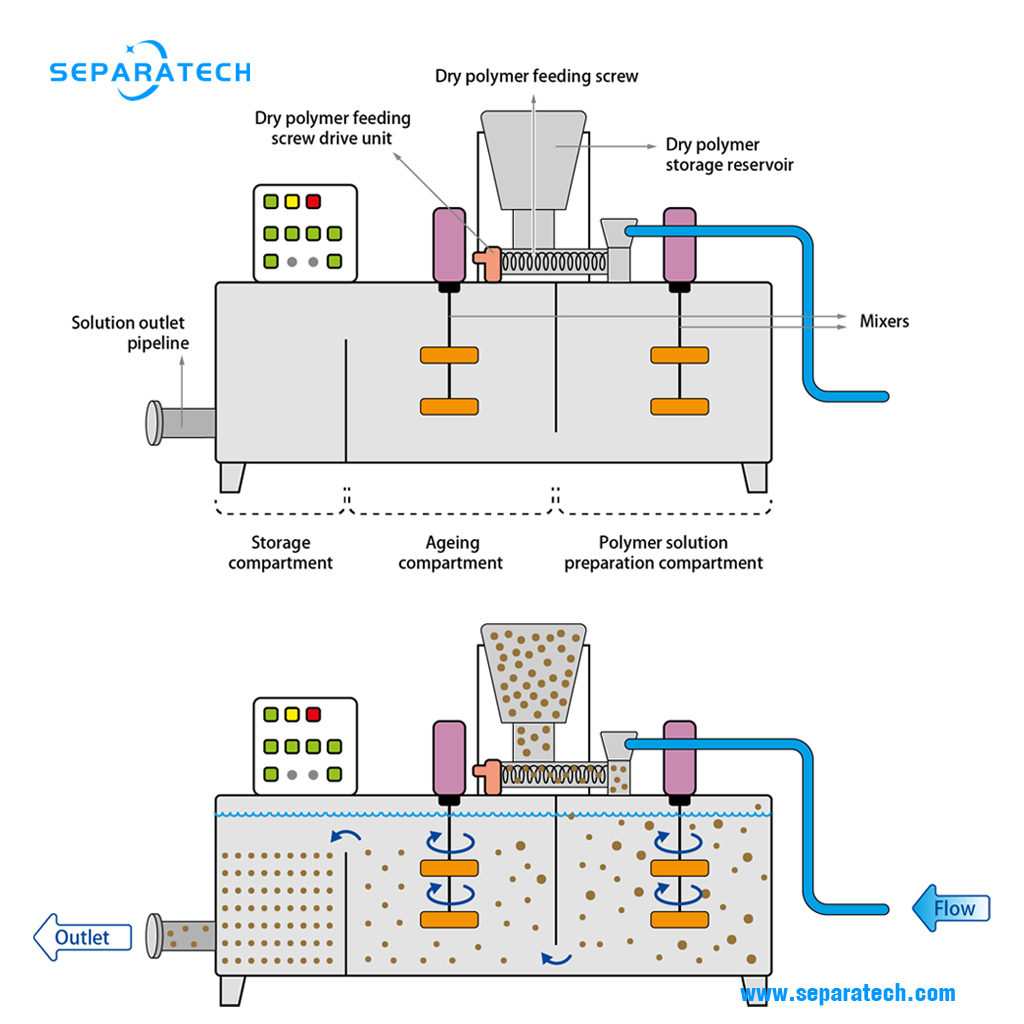Flocculant Dosing System

What is flocculant dosing system?
A flocculant dosing system is a device that mixes and delivers a flocculant solution to a water or wastewater treatment process. A flocculant is a chemical agent that causes suspended particles to clump together and form larger aggregates, called flocs, that can be easily separated from the liquid. Flocculation is an important step in many water and wastewater treatment processes, such as clarification, filtration, thickening and dewatering.
Main components of a flocculant dosing system

1 Jet mixer
2 Dry-polymer feeder
3 Control panel
4 Touch screen
5-7 Stirrer
8 Mixing chamber
9 Maturing chamber
10 Storage chamber
– A storage hopper or bag discharge unit that holds the dry flocculant powder and feeds it to a screw feeder or an eductor-blower system.
– A wetting head that initiates the contact of the dry flocculant with water and forms a pre-mix solution.
– A mixing tank that further hydrates and dissolves the flocculant in water and creates a homogeneous solution of the desired concentration and viscosity.
– A holding tank that stores the flocculant solution and provides sufficient residence time for complete hydration and dissolution.
– A dosing pump that transfers the flocculant solution to the point of application in the water or wastewater treatment process.
Working principle of flocculant dosing system

– The flocculant solution is prepared by mixing a dry or liquid flocculant with water in a tank. The concentration and pH of the solution are adjusted according to the type and dosage of the flocculant.
– A metering pump or a dosing pump transfers the flocculant solution from the tank to the injection point in the liquid stream. The flow rate and pressure of the pump are controlled by a controller or a feedback loop to ensure accurate and consistent dosing.
– The flocculant solution is injected into the liquid stream through a nozzle or a static mixer. The injection point is selected based on the characteristics of the liquid stream, such as flow rate, turbulence, temperature, and pH. The injection point should ensure sufficient mixing and contact time between the flocculant and the suspended particles.
– The flocculant solution interacts with the suspended particles in the liquid stream, causing them to aggregate into larger flocs. The flocs settle faster than the individual particles, forming a sludge layer at the bottom of the tank or basin. The clarified liquid is then separated from the sludge and discharged or further treated.
Customer benefits
– Low-cost investment
– Economical operation
– Safe process and production
– Short delivery times
– Ideally designed as per customer request and application
– Robust and durable industrial construction
– Easy commissioning and operation
– High product quality
– Compact PLC with Touch-Screen
– Modular system with extensive accessories
Major factors in the design and operation
– The type and properties of the flocculant, such as molecular weight, charge density, solubility and stability.
– The required dosage and concentration of the flocculant solution.
– The flow rate and quality of the process water or wastewater to be treated.
– The available space and footprint for the installation of the system.
– The environmental conditions and safety requirements.
Advantages of using a flocculant dosing system
– Flocculant dosing system reduces the labor and handling costs associated with manual preparation and dosing of flocculants.
– Flocculant dosing system ensures consistent and accurate dosing of flocculants according to the process needs and variations.
– Flocculant dosing system improves the performance and efficiency of the water or wastewater treatment process by enhancing the formation and settling of flocs.
– Flocculant dosing system minimizes the waste and environmental impact of flocculants by optimizing their consumption and reducing their spillage.
Typical applications of the flocculant dosing system
– Raw water treatment for drinking water production, industrial water supply or irrigation purposes.
– Boiler feed water treatment for power generation, steam production or heating purposes.
– Oil gathering and separation for oil extraction, refining or transportation purposes.
– Sludge dewatering treatment for municipal or industrial wastewater treatment plants or landfills.
– Various chemical dosing and wastewater treatment processes for different industries, such as mining, pulp and paper, food and beverage, textile, pharmaceutical, etc.
Technical parameters
| Designation | Capacity | Dimension | Volume | ||
|---|---|---|---|---|---|
| L/h | L (mm) | W (mm) | H (mm) | m3 | |
| FDS500 | 500 | 1200 | 600 | 1650 | 0.58 |
| FDS1000 | 1000 | 1450 | 800 | 1750 | 1.16 |
| FDS1500 | 1500 | 1750 | 900 | 1800 | 1.58 |
| FDS2000 | 2000 | 2000 | 1000 | 1800 | 2.00 |
| FDS3000 | 3000 | 2440 | 1000 | 2000 | 2.98 |
| FDS3500 | 3500 | 2440 | 1220 | 2000 | 3.63 |
| FDS4000 | 4000 | 3000 | 1220 | 2000 | 4.46 |
| FDS5000 | 5000 | 3500 | 1220 | 2300 | 5.20 |
| FDS8000 | 8000 | 3600 | 1500 | 2450 | 8.10 |
| FDS10000 | 10000 | 4500 | 1500 | 2450 | 10.13 |
SEPARATECH offer customized solutions for different applications and requirements. These systems can be designed as turnkey modular units or bespoke installations with engineering, installation and maintenance services. Some of these systems also feature patented polymer hydration systems, dose control systems, horizontal and vertical continuous polymer preparation systems, etc., that provide additional benefits and innovations for the customers.